Tonight's Lunar Eclipse Comes With a Rare Twist

A rare event not seen in 372 years will occur early Tuesday morning, when a total lunar eclipse coincides with the winter solstice. While you can't see the solstice, the eclipse promises to be an amazing spectacle.
And if that's not enough, a minor meteor shower is expected to send a few shooting stars through the darkened sky during the height of the eclipse.
Weather permitting, viewers in North and South America, as well as the northern and western parts of Europe, and a small area of northeast Asia should get a great view of the total eclipse of the moon.
On the East Coast of North America, the lunar eclipse begins half an hour after midnight on Tuesday; on the West Coast, it begins around 9:30 p.m. PST Monday. In all cases, the lunar eclipse will be observable before the moon sets in the west just as the sun is rising in the east. Maximum eclipse – the really cool part when the moon is totally in shadow – is at 3:17 a.m. EST/12:17 a.m. PST. [Complete Lunar Eclipse Guide]
How it works
During a total lunar eclipse, the Earth gets between the full moon and the sun, blocking the sun's light from bouncing off the lunar surface. A lunar eclipse can only occur at full moon, but since the three objects are not all exactly in the same plane in space, not every full moon produces an eclipse.
Monday's eclipse is particularly special because it also aligns with solstice – the winter solstice in the Northern Hemisphere, and the summer solstice in the Southern Hemisphere. Winter solstice marks the official beginning of winter. The sun is at its lowest in our sky because the North Pole of our tilted planet is pointing away from it.
Sign up for the Live Science daily newsletter now
Get the world’s most fascinating discoveries delivered straight to your inbox.
Winter solstice is also the shortest day of the year, with the longest night. That means that it should be darker Monday night than any other night this year in the Northern Hemisphere. And because of the lunar eclipse, the moon's light will be dimmed as well, meaning this night will be even darker.
Winter solstice has not coincided with a total lunar eclipse since 1638, according to NASA.
What to look for
Watching an eclipse is simple. Just go out and look up. The most interesting parts occur when the moon plunges into Earth's full shadow, called the umbra, and of course during the period of totality. See times of the 12 stages here.
Depending on how much particulate matter is in our atmosphere, the moon may turn a deep orange or even blood-red during the eclipse.
No telescopes are required to enjoy the eclipse. However, if you have one, you might take it out and enjoy a close-up view of lunar craters while you wait for the full shadow to cross the moon.
Furthermore, the eclipse is falling during the Ursids meteor shower. These underappreciated shooting stars would likely have been outshined by the glow of the full moon occurring at the same time, but since the moon's light will be dimmed by the eclipse, stargazers should get a rare glimpse of the fiery lights created when small space rock bits burn up in Earth's atmosphere.
Lunar lore
Lunar eclipses have fueled much lore and hype and have generated fear through the ages. Some ancients thought a lunar eclipse was a literal bite being taken out of the moon and that the red really was blood. During the 5th century B.C., a lunar eclipse was seen as a bad omen by the Athenians, and they delayed a planned departure of their siege of Syracuse. The result led to the Syracusans changing the course of the war.
Christopher Columbus, knowing an eclipse would occur in 1504, predicted it and thereby used it to frighten natives on Jamaica into feeding his crew.
Nowadays science tells us that eclipses are a simple result of predictable celestial alignments. Yet still many lunar myths persist. Some people swear the full moon affects their behavior, or they blame seemingly strange events on the full moon.
Many researchers have tried for decades to find statistical connections between the full moon and human biology or behavior, from epileptic seizures to psychiatric visits to menstrual cycles. Yet the majority of sound studies find no connection, while some have proved inconclusive, and many that purported to reveal connections turned out to involve flawed methods or have never been reproduced. [The Truth About Lunar Effects on You]
The full moon is beautiful, and a total lunar eclipse is wondrous, but beyond making lovers swoon, there are few if any actual physical connections between the moon and you.
SPACE.com writers Clara Moskowitz, Robert Roy Britt, Joe Rao and Geoff Gaherty contributed to this article. This article was provided by SPACE.com, a sister site of Live Science.










